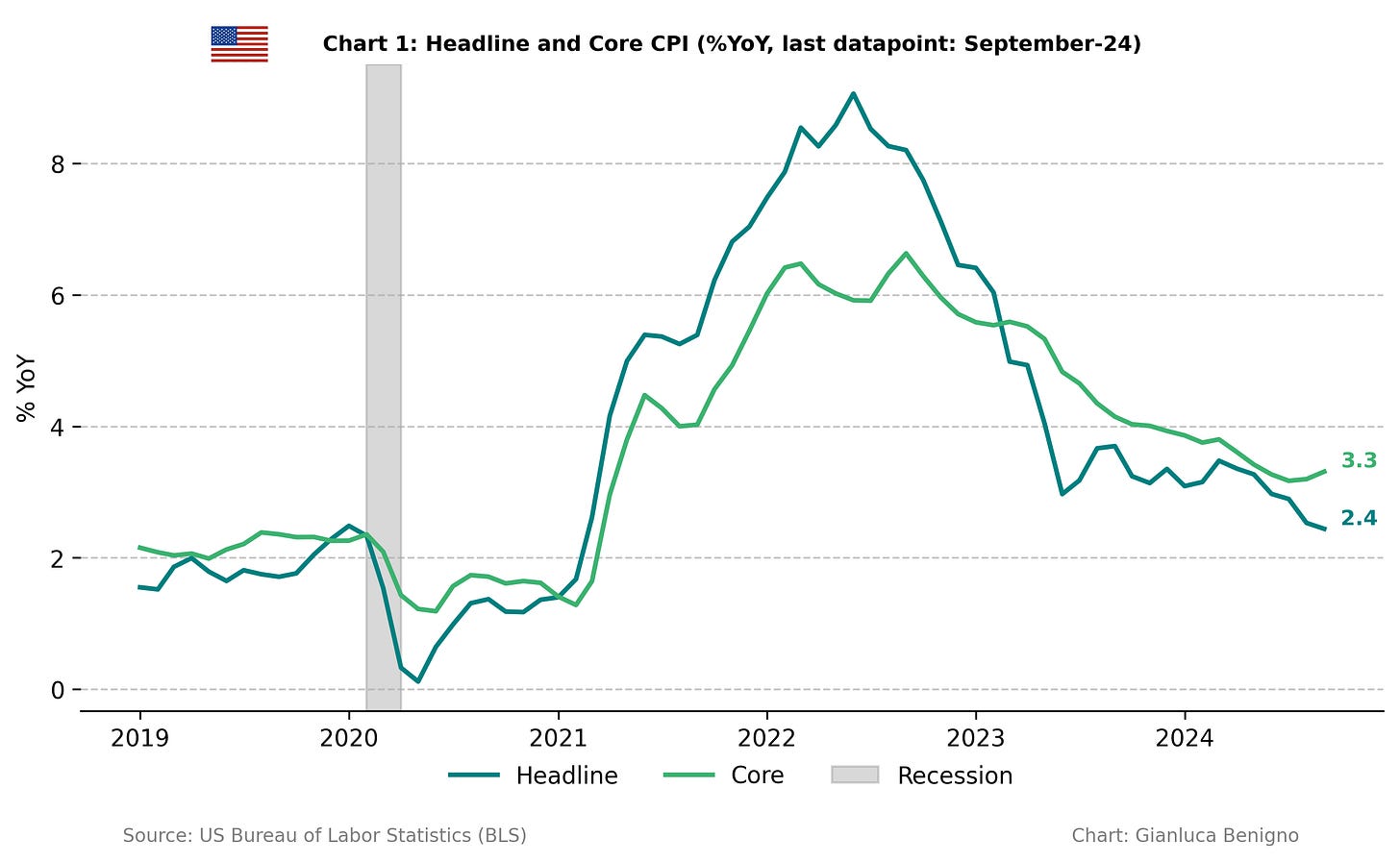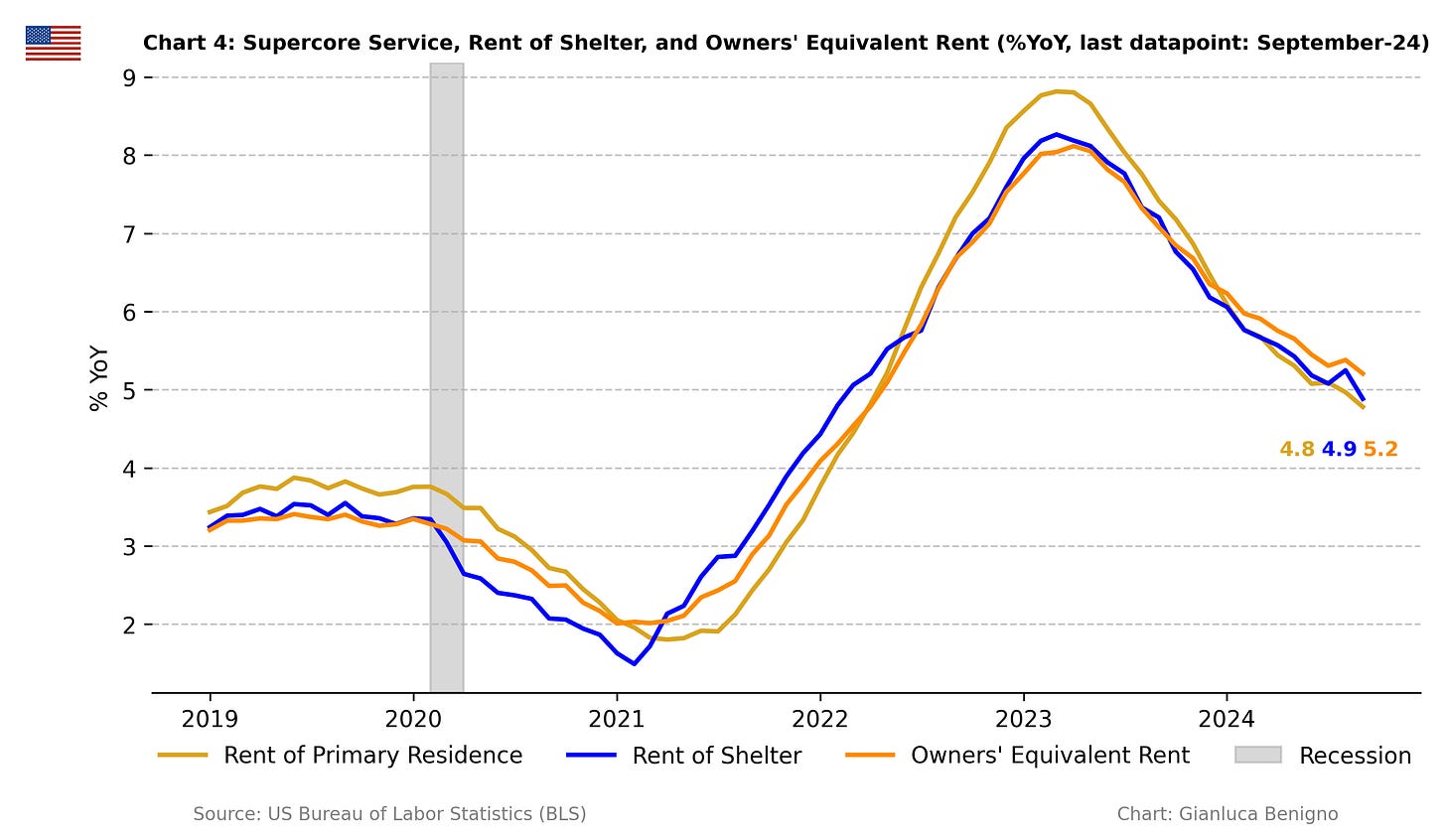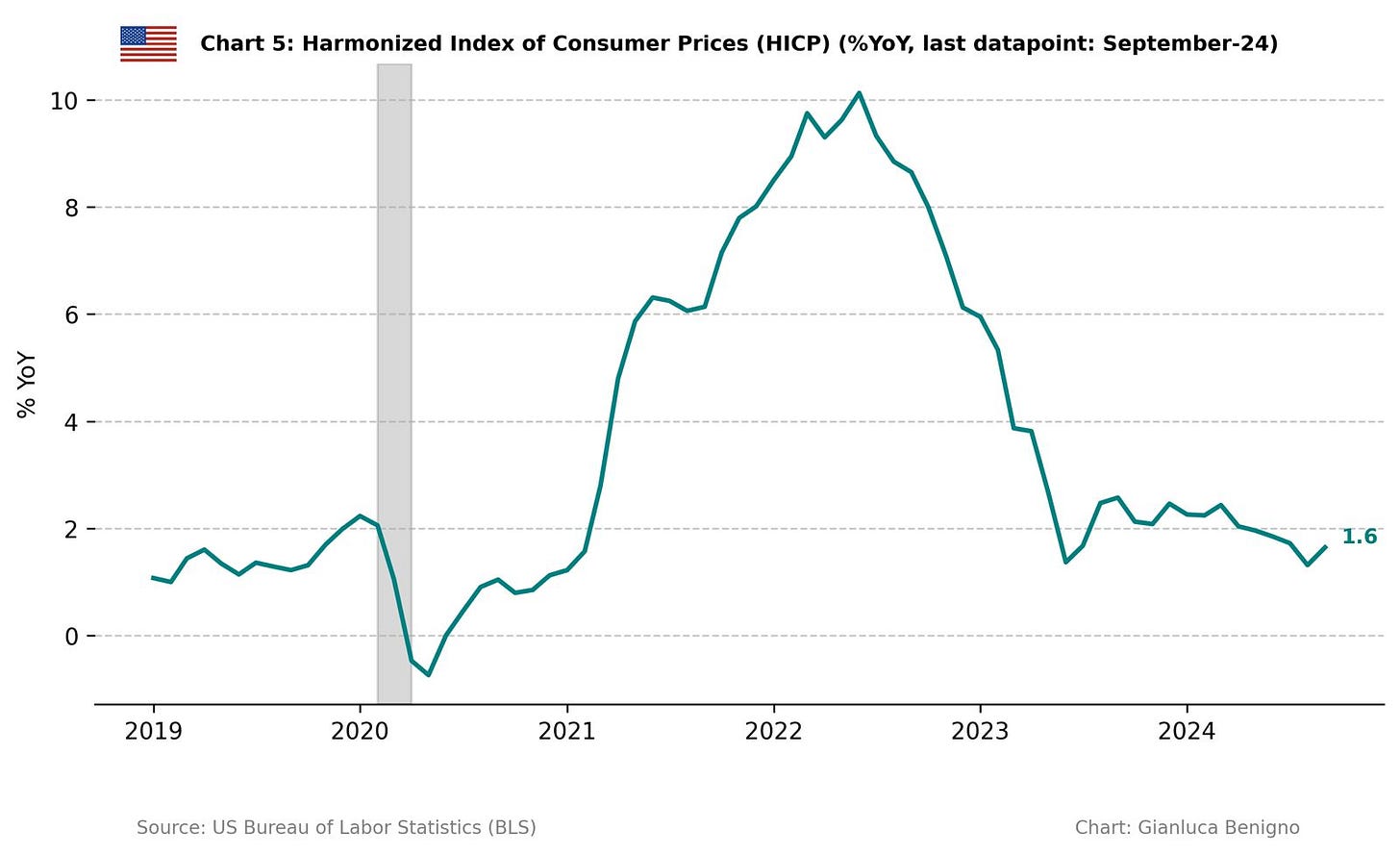September-24 U.S. CPI Inflation report
Slow path of core and service disinflation persists in September
Key takeaways:
The overall Consumer Price Index (CPI, n.s.a.) increased by 2.4% year-on-year (YoY) (n.s.a) in September, above the consensus expectation of 2.3% YoY and below the August reading of 2.5% (2.6% s.a.) YoY increase.
Core CPI in September was 3.3% YoY (n.s.a.), which is above August’s reading of 3.2% (3.3% s.a.) YoY (s.a.) and above the consensus forecast at 3.2% YoY.
Once more, inflationary pressures are primarily concentrated in the core service sector with an increase of 4.7 % year-on-year, slightly lower than the 4.9% (YoY) observed in August. In contrast, the goods sector is experiencing deflation with a decrease of 1% year-on-year, a lower decrease than the 1.9% (1.7% s.a.) year-on-year decline recorded in August.
The primary factor behind recent inflationary pressures is still the shelter component of the Consumer Price Index (CPI). Shelter increased by 4.9% YoY in September compared to 5.2% (5.2% s.a.) YoY in August. The month-on-month increase was 0.2%, much lower than August’s 0.4% (0.5% s.a.) MoM.
The current reading is consistent with a slow benign disinflationary process and the continuation of the easing cycle by the Fed in 2024. However, while disinflationary forces are in play, persistent inflationary pressures in the service sector are slowing the progress toward the 2% target.
Related posts (with links)
US August-24 CPI Inflation Report (Previous Release)
US July-24 CPI Inflation Report (previous release)
US June-24 CPI Inflation Report (previous release);
US May-24 CPI Inflation Report (previous release);
50 or 25 bps? The cut that could split the Fed (context post);
Post FOMC update: the Fed and the Market Shifts (context post);
Switzerland September-24 CPI Inflation Report (other release);
Review of the Inflation Release
The Consumer Price Index (CPI) rose by 2.4% (s.a.) year-on-year in September (Chart 1), which is above the market consensus (2.3% YoY) and below August’s figure of 2.5% (2.6% s.a.) YoY. On a month-on-month basis, there was an increase of 0.2%, above the market consensus and August’s figure of 0.1% (0.2% s.a.).
Core CPI (excluding food and energy) increased by 3.3 % year-on-year (Chart 1), above the market consensus of 3.2% YoY and August’s figure of 3.2% YoY, (3.3% s.a.). On a month-on-month basis, core CPI rose by 0.3%, the same rate as the 0.3% (0.3% s.a.) recorded in August and above the consensus forecast of 0.2% MoM.
Core services (services excluding energy) remain the primary driver of inflationary pressures. In September, core services increased by 4.7% YoY (below the 4.9% (both n.s.a. and s.a.) YoY recorded in August), while core goods (goods excluding energy) experienced another decline, by 1% YoY (lower than the 1.9% (1.7% s.a.) YoY decline recorded in August). The current release confirms a slow adjustment of core CPI, with a month-to-month reading higher than expected.
The following chart (Chart 2) illustrates this dichotomy between core goods and core services:
As anticipated, the CPI in September was primarily driven by the housing component (Tables 1 and 2). The overall shelter component rose by 4.9% year-on-year in September, lower than the 5.2% (5.2% s.a.) figure recorded in August. Noticeably, on a month-on-month basis, the shelter component increased by 0.2%, a much lower reading than the 0.4% recorded in August.
Supercore services (core services excluding shelter – Chart 3) increased by 4.4% year-on-year, rising slightly relative to the 4.3% (4.3% s.a.) increase in August. On a monthly basis, the supercore component has increased by 0.5% MoM much higher than the 0.1% (0.1% s.a.) MoM observed in August.
Core services (excluding energy) prices increased by 4.7% year-on-year in September, lower than the 4.9% s.a. YoY recorded in August. On a month-on-month basis, core services increased by 0.3%, the same increase as the 0.3% (0.4% s.a.) rise in August.
Core goods (excluding food and energy) prices continued their deflationary trend, declining by 1% year-on-year in September, a lower decline than the 1.9% (1.7% s.a.) YoY observed in August. On a month-on-month basis, core goods are now increasing at 0.4% in September, higher than the flat reading of 0.0% (-0.2% s.a.) MoM in August and higher than the decline of 0.4% (-0.3% s.a.) MoM in July.
The Bureau also published the Harmonized Index of Consumer Prices (HICP), following the ECB’s methodology. According to the BLS: “The HICP differs from the U.S. Consumer Price Index (CPI) in two major respects. First, the HICP includes the rural population in its scope. Second, and probably more importantly, the HICP excludes owner-occupied housing”.
Chart 5 reveals that by excluding the owner-occupier rent component from the CPI, the inflation rate has ticked higher, at 1.6% in September compared to 1.3% (n.s.a.) (1.3% s.a.) year-on-year in August 2024.
Summary
The overall pattern of inflation has given confidence to the Fed in the disinflationary process towards the 2% as they started the easing cycle in September 2024. The latest reports confirm that core inflation is adjusting slowly on a month-to-month basis, especially within the core services sector, despite some improvement in the most recent data. A promising sign in this latest report is the easing of the shelter inflation component on a monthly basis. On the other hand, there was a significant uptick in the monthly reading of the supercore service component suggesting a cautious approach to interest rate cuts at least by focusing on the inflation side of the Federal Reserve’s mandate.
Table 1: CPI by components (% YoY)
Source: Bureau of Labor Statistics (BLS)
Table 2: CPI by components (% MoM)
Source: Bureau of Labor Statistics (BLS)











Unless I'm mistaken, inflation is becoming structural, just like the housing shortage.
It is a possibility: disinflation in the service sector is progressing at a very slow pace, and the disinflationary impact of goods prices is likely to fade soon.